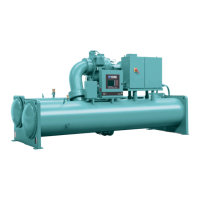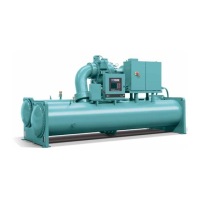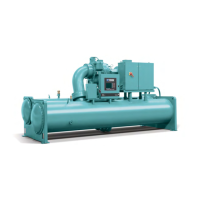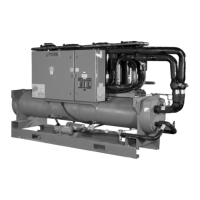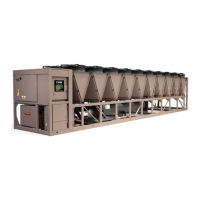FORM 160.77-O2
ISSUE DATE: 11/15/2011
JOHNSON CONTROLS
12
SECTION 1 - YKEP CHILLER OVERVIEW
CAPACITY CONTROL OPERATION
Chiller Applications
Much of the function of the YKEP Control System is
dedicated to chiller capacity control. Sensors register
system conditions that are used to infer the total cool-
ing load and make necessary adjustments to the system
components. A complete list of sensors is shown in
Table 1 on Page 18.
There are two primary mechanisms by which cooling
capacity is controlled: pre-rotation vanes, and the hot
gas bypass valve. The primary directive of the Control
System is first to maintain safe operating conditions,
then to keep the system online, and finally to efficient-
ly maintain setpoints.
The interaction of capacity control subsystems is com-
plex, and can be better understood by referring to the Ca-
pacity Control Model shown in Figure 5 on Page 13.
The Capacity Control philosophy of the York YKEP
chiller control system allows efficient, fully automated
control, without need for operator intervention. The
YKEP control system is designed for industrial process
applications. This control system also monitors and
displays all safety aspects of the chiller and provides
alarms and a shutdown if safety limits are exceeded. If
operator intervention is required, manual controls are
provided on the Electronic Operator interface, for all
electric actuators.
The Capacity Controls algorithm automatically seeks
out the most efficient operation of the YKEP chiller. The
pre-rotation vanes are automated to obey the tempera-
ture controller to maintain process water production. In
cases of low load, the pre-rotation vanes automatically
throttle and are limited to a minimum anti-surge posi-
tion, which is calculated from a head curve. To provide
light duty operation, the hot gas recycle valve is seam-
lessly throttled open according to temperature demands.
This keeps the centrifugal compressor out of surge and
maintains process water production.
In cases of high load, which exceeds the motor current
usage, the capacity controls algorithm automatically
unloads the system to maintain a restriction on power
consumption. In the same way, conditions of high dis-
charge pressure or low suction pressure override the
production of process water in the interests of keeping
the chiller system online.
In cases of light load and low head, the economizer
compressor is dropped offline and the unit will be run
with the primary compressor like a single-stage YK
chiller.
In cases of high load, the economizer compressor is
brought back online to perform the additional gas com-
pression. The unit runs in compound mode with the
flash economizer in the cycle.
Start Up
When the chiller is started from shutdown, until the
Leaving Chilled Liquid Temperature comes within 2
degrees F of the Leaving Chilled Liquid Temperature
Setpoint the Hot Gas Bypass valve is driven closed at
a programmed ramp rate. When the Hot Gas Bypass
valve reaches full closed, the Primary compressor pre-
rotation vanes are driven open at a programmed ramp
rate. These program points are set on the Primary Ca-
pacity Tuning screen. When either; 1) the pre-rotation
vanes reach full open or 2) the LCHLT comes within 2
degrees F of setpoint, the ramp control stops and con-
trol of the Hot Gas valve and pre-rotation vanes switch-
es to the capacity control PID and anti-surge controls.
High current, low evaporator pressure or high condens-
er pressure overrides are always applicable when their
thresholds are exceeded.
Role of Hot Gas Bypass
The natural solution on a centrifugal chiller applica-
tion is that when the surge line is approached with a
decrease in load, the mass flow cannot be decreased
without aerodynamic instability; therefore the hot gas
bypass is used to supplement mass flow. This supple-
mental mass flow creates a source of inefficiency in
the refrigeration cycle and allows the chiller to run at
lower evaporator loads than it could without hot gas.
Major Capacity Control Devices
1. Compressor Pre-rotation Vanes
The compressor pre-rotation vanes (PRV's) are
internal guide vanes in the suction flow path to
the impeller wheel. The PRV's are used to throttle
the refrigerant flow through the system as a means
of controlling capacity in response to the leaving
chilled water temperature. If the leaving chilled
water temperature falls below the setpoint, the
PRV's are partially closed until the net cooling is
reduced and the leaving chilled water returns to
setpoint.
In the event of high motor power, the capacity
control signal is over-ridden and the compressor
PRV's are closed to keep the motor power down.
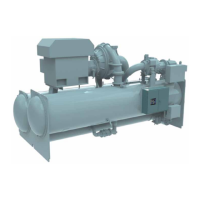
